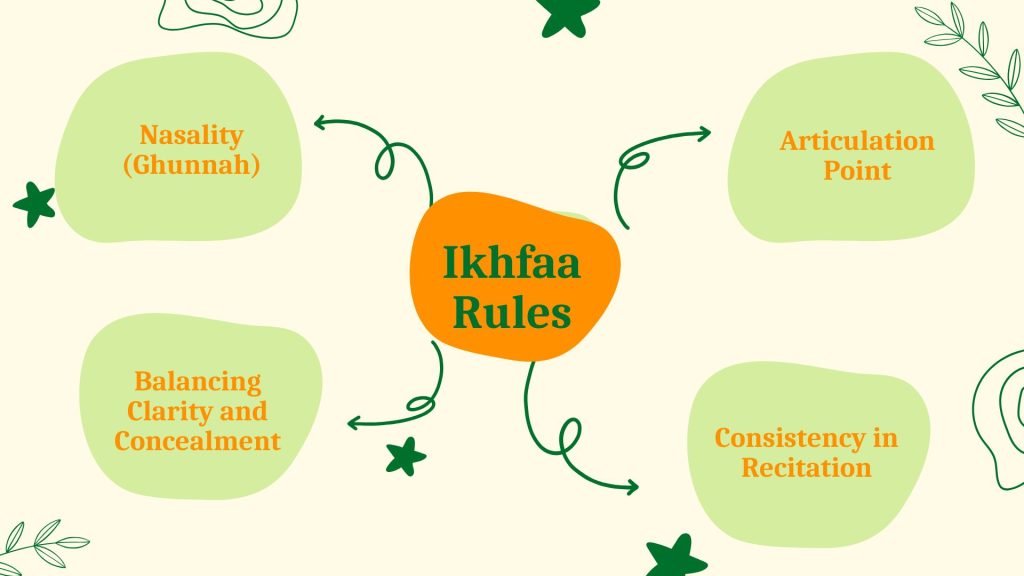Tajweed, the art of Quranic recitation, is deeply rooted in precise pronunciation and phonetic principles. With learning these rules, the bond between us and the Quran is strengthened. Among its key rules is Ikhfaa, a nuanced technique essential for proper articulation of the Quranic text. This article explores Ikhfaa in depth, detailing its definition, rules, types, and applications, with the aim of enhancing your understanding and implementation of this critical aspect of Tajweed.
We should remember ourselves repeatedly to put our intention why we have to learn tajweed, how it is a necessary thing in our daily recitation of the Quran, how it makes a strong relation with the meanings and verses. This science is considered as learning the Quranic sciences.
Abu Umamah (May Allah be pleased with him) reported:
I heard the Messenger of Allah (ﷺ) saying, “Read the Qur’an, for it will come as an intercessor for its reciters on the Day of Resurrection.”
What is the meaning of ikhfaa?
The term Ikhfaa (الإخفاء) linguistically means “to conceal” or “to hide.” In Tajweed, it refers to a specific rule of pronunciation where a sound is articulated between full clarity (Iẓhar) and full merging (Idgham), resulting in a soft, nasalized pronunciation. This rule applies when a Noon Sakinah (نْ) or Tanween (ًٌٍ) is followed by one of the fifteen letters of Ikhfaa. It is to pronounce the letter in a way between Iẓhar and Idghām with no Shaddah, taking into account that ghunnah should remain in the first letter, i.e. the Noon Sakinah and Tanween.
Ikhfaa combines the qualities of partial clarity and a slight nasalization, striking a balance between hiding and revealing the sound. This delicate execution ensures a harmonious and melodious recitation of the Quran.
What Are Ikhfaa Letters?
Ikhfaa Haqiqi Letters refer to 15 specific Arabic letters:
- Ṣād
- Dhāl
- Thaā’
- Kāf
- Jīm
- Shīn
- Qāf
- Sīn
- Dāl
- Ṭaā’
- Zay
- Faā’
- Taā’
- Ḍad
- Ẓaā’.
When these letters follow a Noon Saakinah or Tanween, they create a sound of partial concealment, blending smoothly with the following letter.
Ikhfaa Al-Shafawi Letters include only one letter, Baā’. This occurs specifically when a Meem Saakinah is followed by Baā’, resulting in a nasalized sound while maintaining clarity in pronunciation.
How many types of Ikhfa are there?
There are two types of Ikhfaa in Tajweed rules,
- Ikhfaā’ Ḥaqīqi
- Ikhfaā’ Shafawi
1. Ikhfaā’ Ḥaqīqi
If one of these aforementioned letters comes after Nūn Sākinah, be it in one word or two words, or Tanwīn, Ikhfaā’ Ḥaqīqi (i.e. True Ikhfaā’) should take place.
Reason for Ikhfaā’ Ḥaqīqi:
- The articulation points of these letters are not close to that of the Noon letter required for making Idghām.
- The articulation points of these letters are not far from the articulation point of Noon required for making Iẓhār.
Accordingly, the rule of Ikhfaā’ is applicable in these cases, warning that the reader should keep away from sticking his tongue above the upper incisors while making Ikhfaā’. Besides, to keep away from this mistake, the tongue should be kept a little bit from these incisors.
What should be done so that Ikhfaā’ is realized:
- Prepare the mouth as per the articulation point of the following letter.
- Fully pronounce the ghunnah from the nasal passage.
- Pronounce a small voice from the mouth due to the non-closure of the articulation point of the Noon letter (the tongue part).
Levels of Ikhfaā’,
There are three levels in Ikhfaa,
- The Highest level; it occurs with the following letters (Dāl, Taā’ and Ṭaā’) because the articulation point of the Nūn letter is close to the articulation points of these letters.
- The lowest level; it occurs with the following two letters (Qāf and Kāf) because the articulation point of the Noon letter is far from the articulation points of these two letters.
- Medium level; it occurs with the remaining 10 letters of Ikhfaā’.
Examples for Al-Ikhfaā’ Al-Ḥaqīqi:
- Andādā, أَندَادًا.
- Yanṭeqūn, Allah will take retribution from him “Noon Sakinah followed by Taa’” فَيَنتَقِم
- Men Faḍl Allah, This is from the Grace of Allah “Noon Sakinah followed by Faa’” مِن فَضْلِ اللَّهِ
- Qaman Ḍāllīn, a people astray. “Tanween followed by Ḍad” قوْمًا ضَالِّين
- Fanẓur, so look what you think! “Noon Sakinah followed by Ẓaā’”. فَانظُرْ
- Man Ẓalama, who does wrong “Noon Sakinah followed by Ẓaā’”. مَن ظَلَمَ
Mark of Ikhfaā’ Ḥaqīqi in the Calligraphy of the Muṣḥaf
- Noon Sakinah: Removing the Sukūn from the Nūn letter, with no Shaddah placed on the concealed letter.
- Tanween: The two diacritic marks of Tanwīn should be consecutively following each other, with no Shaddah placed on the concealed letter: ٌ, ٍ, ً
Difference between Ikhfaā’ and Idghām
The sound of them is nearly like each other, but now we will talk about what are the differences?
There is no Shaddah with Ikhfaā’ while Idghām has. Ikhfaā’ occurs at the letter where it would take place while Idghām takes place in the letter in which the Nūn Sākinah and Tanwīn are merged. Ikhfaā’ might occur in one word or two words while Idghām cannot be realized but in two words. Ghunnah of Ikhfaā’ is in the first letter, that is, Nūn Sākinah or Tanwīn like Andāda. Besides, it (i.e. the ghunnah) follows the letter of Ikhfaā’ as to heaviness and lightness, such as Man Taḥtahā. As for the Gunnah of Idghām, it is in the second letter, that is, the letter of Idghām with ghunnah like Men Waly.
Remarks
Ikhfaā’ is of two kinds:
- Ikhfaā’ of the diacritic mark as in the Saying of Allah, “Lā Ta’mannā …” (The Qur’an, 12:11 surah Yusuf) where 1/3 of the diacritic mark of Ḍammah is mentioned in case of Rawm.
- Ikhfaā’ of letter; it is of two kinds:
1) To pronounce part of the letter as is the case in the Ikhfaā’ Shafawi (i.e. oral concealment).
2) Not to pronounce it totally as is the case in Ikhfaā’ Ḥaqīqi (the true concealment).
2. Al-Ikhfaā’ Al-Shafawi (i.e. Oral Concealment)
It means to conceal the Mīm Sākinah in case it is followed by the Baā’ letter; this cannot be realized except in two consecutive words, taking into account that ghunnah should be completely pronounced.
Examples for Ikhfaā’ Shafawi:
- Man Ya‘taṣem Bi Allah, And whoever holds firmly to Allah “Meem followed by Baa’” وَمَن يَعْتَصِم بِاللَّهِ
- Wa Hum Bi Al-Ākhirah, concerning the Hereafter, disbelievers “Meem followed by Baa’”. وَهُم بِالْآخِرَةِ
- Yakhshawn Rabbahum Bi Al-Ghayb. Those who fear their Lord unseen “Meem followed by Baa’”. يَخْشَوْنَ رَبَّهُم بِالْغَيْبِ
Reason why it is called Al-Ikhfaā’ Al-Shafawi:
That is because the Mīm and Baā’ letters come out from the two lips, and thus they are similar to each other in that they share most of characteristics with each other, a case under which concealment will make articulation an easy thing.
Remark:
In case the Mīm Sākinah is followed by the Baā’ letter, two rules are pertaining to it, that is, Ikhfaā’ or Iẓhār. This means that the rule of Ikhfaā’ is what is chosen by the majority of reciters, since the Mīm Sākinah is concealed when the Nūn Sākinah is changed into Baā’; that is to say that the Nūn Sākinah is changed into Mīm and it is known that when Mīm meets with Baā’, Ikhfaā’ Shafawi is applicable.
Now, you should ask what are the differences between the two types?
Difference between Ikhfaā’ Ḥaqīqi and Ikhfaā’ Shafawi
As for Ikhfaā’ Ḥaqīqi, the Noon Sākinah or Tanwīn should be concealed with the 15 letters mentioned above. Besides, the Nūn letter is concealed and the ghunnah remains.
As for Ikhfaā’ Shafawi, the Mīm Sākinah is what should be concealed when followed by Baā’, a matter that is realized through pronouncing part of the Mīm letter and concealing the other while the ghunnah should remain.
Idghām Mutamāthilayn Ṣaghīr (Small Assimilation of Two Identical Letters)
It occurs with just one letter, namely: – the Mīm letter. So, if the vowel Mīm letter comes after the Sākinak Mīm letter, be it in one word or in two words, Idghām becomes compulsory and is thus called Idghām Mutamāthilayn Ṣaghīr with ghunnah.
What are the Rules of Ikhfaa in Tajweed?
To implement Ikhfaa correctly, several principles must be followed:
- Nasality (Ghunnah): When reciting with Ikhfaa, the sound of Nun Sakinah or Tanween is slightly hidden and accompanied by a nasalized hum (Ghunnah). The duration of the Ghunnah is approximately two counts.
- Articulation Point: The exact articulation of Ikhfaa depends on the letter following Nun Sakinah or Tanween. The tongue approaches the articulation point of the following letter without fully touching it.
- Balancing Clarity and Concealment: The sound is neither fully pronounced (as in Izhar) nor completely merged (as in Idgham). Instead, it is softly articulated.
- Consistency in Recitation: Ikhfaa must be applied consistently whenever a triggering letter follows Nun Sakinah or Tanween, regardless of its placement in the word or verse.

Practical Application of Ikhfaa
To perfect Ikhfaa, consistent practice is crucial.
Here are steps to master this rule:
- Identify Trigger Letters: Memorize the fifteen letters of Ikhfaa and practice recognizing them in the Quran.
- Work on Nasalization: Practice producing a smooth nasal sound, ensuring it lasts for two counts.
- Focus on Articulation Points: Familiarize yourself with the articulation points of the Ikhfaa letters to adjust your pronunciation accordingly.
- Ask for help from a Teacher: Learning Tajweed under the supervision of a qualified teacher ensures that mistakes are corrected and proper techniques are reinforced.
- Record and Review: Record your recitation and compare it with recordings by expert reciters to identify areas for improvement.

Common Mistakes in Ikhfaa
Despite its importance, Ikhfaa is often misapplied. Common errors include:
- Overemphasizing the Nasalization: Excessive Ghunnah can distort the sound and affect the rhythm of recitation.
- Under Pronouncing the Concealment: Failing to create the balance between clarity and concealment results in either Izhar or incomplete merging.
- Ignoring Articulation Points: Misplacing the tongue relative to the following letter’s articulation point alters the intended sound.
Significance of Ikhfaa in Quran Recitation
Ikhfaa is more than just a rule of Tajweed; it plays a vital role in preserving the beauty and integrity of Quranic recitation. Its significance includes:
- Enhancing Melodic Flow: Ikhfaa contributes to the rhythmic and melodic quality of the Quran, making its recitation pleasing to the ear.
- Preserving the Quranic Text: Proper application of Ikhfaa ensures accurate transmission of the Quran as it was revealed.
- Facilitating Reflection: The deliberate pace and careful articulation required by Ikhfaa encourage deeper reflection on the meanings of the verses.
Conclusion
Ikhfaa is an essential rule in Tajweed that requires a delicate balance of concealment and clarity. By mastering this rule, reciters not only enhance their technical skills but also deepen their connection to the Quran. Whether you are a beginner or an experienced reciter, a thorough understanding of Ikhfaa is crucial for achieving excellence in Quranic recitation.
Practicing Ikhfaa enhances not only the technical aspect of recitation but also the spiritual connection to the Quran. By mastering this rule, reciters achieve a seamless flow in their recitation, embodying the reverence and beauty that the words of Allah deserve.
Through consistent practice, reliance on knowledgeable teachers, and reflection on the significance of Tajweed rules, you can elevate your recitation and embody the reverence that the Quran demands.

About Author
Related Blogs
Dive Deeper into Related Topics

